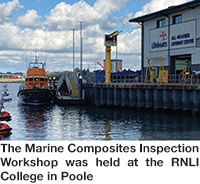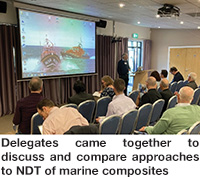Marine Composites Inspection Workshop 2021: ‘Sea’ what you are missing…
22/12/2021
A two-day workshop organised by the BINDT Composites Group focusing on the practice of NDT as performed in the field of marine composites was held in October at the Royal National Lifeboat Institution (RNLI) College, Poole.Rob Rose from the National Composites Centre (NCC) and Chair of BINDT’s Composites Group opened the event with a short introduction to the two-day programme, which provided a mix of technical presentations, exhibitor demonstrations and question and answer sessions.
The workshop brought together operators, practitioners, suppliers, manufacturers and regulators to demonstrate, discuss and compare approaches to NDT for different types of marine composite materials and structures, providing an opportunity to discuss the challenges and solutions that arise from NDT within the marine sector. The workshop covered the need for the implementation of standards and requirements that drive the NDT approach, introduced a variety of inspection methods and techniques currently in use within the sector and looked to embrace best practice as a means of continued quality control for the testing of marine composite materials and their associated structures.
The event continued with the themes raised at a past event, which recognised that: “while a significant amount of non-destructive testing (NDT) is already performed on marine composites, the sector needs further support in a number of areas, including the development of NDT acceptance criteria at the design stage for manufacturing and in-service defects, guidance on the appropriate NDT method and inspection process selection”[1].
Paul Miller from Millstream Underwriting gave an enthralling presentation on day two of the event, which concluded that mast and boat production was now becoming so expensive that insurance agencies were looking to mitigate against future risk through the use of accepted NDT inspection methods and techniques deployed by competent persons. The theme of a ‘competent person’ ensuring against in-built latent defects, and that in-service repairs had been completed to the standard required to insure against future failure, which may then prove catastrophic, was covered. The incident in 2014 involving the yacht Cheeki Rafiki was discussed; the vessel suffered a number of light groundings to her keel over her racing life, which subsequently led to uncontained keel detachment, capsize and subsequent loss of life.
 Paul highlighted one main area of concern, which was that NDT is still not being fully embraced and understood by owners and manufacturers alike; rather than being seen as a benefit that might additionally lock-in value to a boat’s resale potential and safe operation, the old adage that NDT is seen as a cost burden rather than a benefit still largely remains true within certain areas of the sector.
Paul highlighted one main area of concern, which was that NDT is still not being fully embraced and understood by owners and manufacturers alike; rather than being seen as a benefit that might additionally lock-in value to a boat’s resale potential and safe operation, the old adage that NDT is seen as a cost burden rather than a benefit still largely remains true within certain areas of the sector.Reoccurring themes were raised over the two days concerning the fact that there are still no agreed NDT survey standards or industry agreements on acceptable defect size; however, it was also discussed that perhaps setting a minimum defect size is not the holy grail in ensuring a vessel’s overall serviceability. In some circumstances, it would be of greater benefit to allow defects to remain present within the structure, but to ensure the structure is subject to continued NDT monitoring processes rather than risk causing greater structural damage and additional weight penalties, where it can be demonstrated that this approach does not affect the ultimate safety and serviceability of the vessel.
All present agreed that an International Organization for Standardization (ISO) NDT survey standard would be hugely beneficial to the industry and that currently there remain too many unqualified surveyors offering cheap and possibly ineffective NDT services to which owners continue to be attracted. Just as within the aerospace sector, where regulation and standardisation is the norm, it was thought that producing any such ISO survey standard would be the benchmark required to raise the professionalism of the industry and that education would be the key focus for the Marine Composites Certification Working Group (WG), a WG that is in the process of developing a certification scheme for marine composites inspection. Currently, this group is chaired by Chris Minton of Minton, Treharne and Davis and is focusing on providing NDT certification in the first instance for ultrasonic testing and laser shearography. The certification programme will produce an appropriate NDT syllabus for the NDT methods selected for development as well as the provision of a dedicated Marine Composites Product Technology module to ensure the NDT technician has a greater understanding of the materials and structures they may be required to test.
Added realism was brought to BINDT’s certification development programme when Giles Waterhouse of International NDT Ltd spoke on phased array ultrasonics for enhanced evaluation and monitoring purposes, while John Tyrer, Professor of Optical Instrumentation with the Department of Mechanical, Electrical and Manufacturing Engineering at Loughborough University, spoke on the quantitative structural shearographic NDT of composite maritime structures, covering lessons learned from 30 years of testing maritime vessels. These presentations, coupled with others provided by Gary Whalley and Laura Hayday from Babcock International, among many others, were exceptionally informative as to the progress achieved since the earlier event held in 2018.
 Delegates were also able to experience real-time, sector-focused demonstrations provided by a number of equipment manufacturers, who were on hand to discuss and demonstrate solutions to the issues of testing marine composite structures and materials. Representatives from Baugh & Weedon, Dantec Dynamics, Dolphitech, High Technology Sources, Inspection Tech, JR Technology and Testia provided delegates, who gathered in small focus groups, with insight into the advancement of technology and how technology may be of benefit in ensuring the serviceability of the owner/operator’s vessel when deployed by confident and competent persons subject to best practice.
Delegates were also able to experience real-time, sector-focused demonstrations provided by a number of equipment manufacturers, who were on hand to discuss and demonstrate solutions to the issues of testing marine composite structures and materials. Representatives from Baugh & Weedon, Dantec Dynamics, Dolphitech, High Technology Sources, Inspection Tech, JR Technology and Testia provided delegates, who gathered in small focus groups, with insight into the advancement of technology and how technology may be of benefit in ensuring the serviceability of the owner/operator’s vessel when deployed by confident and competent persons subject to best practice.The full programme can be seen on the BINDT website at:
www.bindt.org/events/PastEventsandWebinars/marine-composites-inspection-workshop-2021
Reference
- Report from the Workshop on NDT Requirements for Marine Composites, The British Institute of Non-Destructive Testing, Southampton, UK, 27 February 2018.